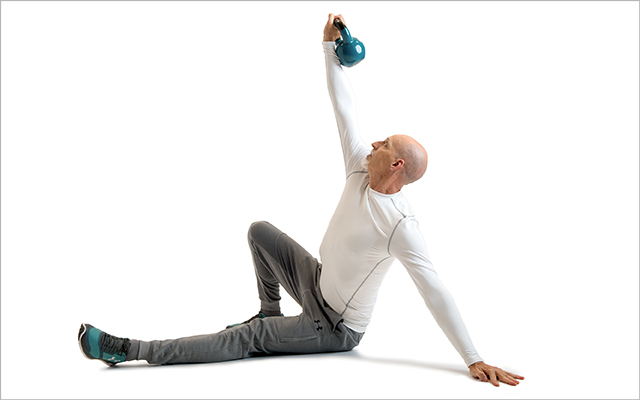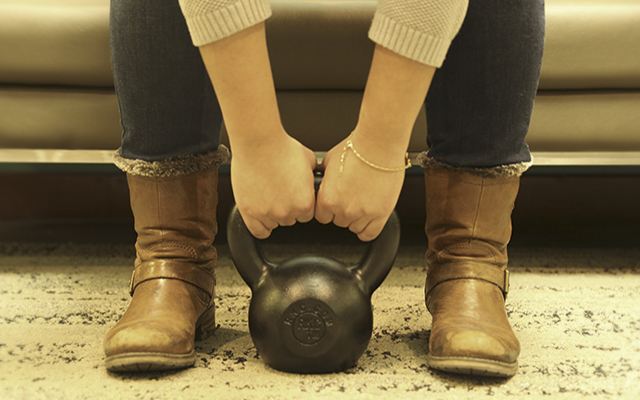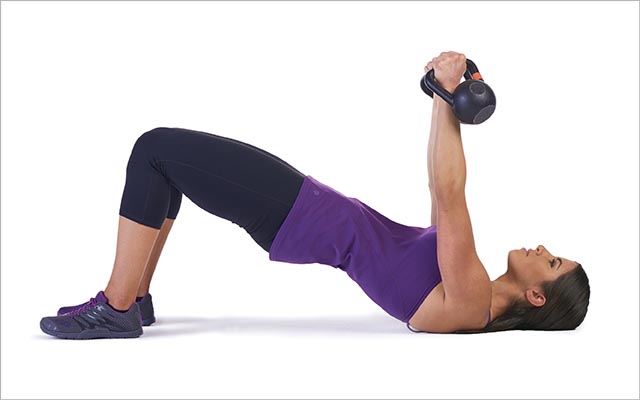Lower-back discomfort is a common complaint among novice kettlebell enthusiasts, says Experience Life fitness editor Maggie Fazeli Fard, RKC. Luckily, form adjustments can make a huge difference.
The key to mastering the kettlebell swing is to remember that you are the master, she says. You swing the kettlebell; the weight does not swing you. This small mindset shift can create big changes. Also try these form tips:
- Stand tall. Stack your shoulders, rib cage, and hips in a straight line. Keep them stacked. The swing is essentially a moving, upright plank — at the top position, with arms outstretched, you are in an upright version of a solid plank. A proper plank does not feature hunched shoulders, arched back, or flared ribs.
- Start the swing by hinging at the hips. This is different from bending over. To practice this, stand a couple of inches from a wall and attempt to tap your butt back against it. If you succeed, step a little farther away and tap again. Keep going until you get a good sense of how it feels to push your hips back versus simply bending forward at the waist. Learning to hinge your hips will protect your lumbar from overflexing.
- Finally, remember there is no pulling in kettlebell swings. Your hands do not pull the weight up to chest height; they guide the direction of the kettlebell as your hips propel it. Likewise, on the downswing, the kettlebell does not pull you down; you press the kettlebell down, high and back between your legs. Controlling the kettlebell will keep it from pulling you out of alignment, which can also strain your back.
If these tips don’t relieve your discomfort, ask a professional coach for personalized feedback. If you experience pain while swinging, stop immediately and talk to your healthcare provider; the problem may be more serious than poor kettlebell form.
This originally appeared as “I love swinging kettlebells, but my back often hurts afterward. What am I doing wrong?” in the May 2018 print issue of Experience Life.
We Have Your Back
EL’s fitness editor explains how to protect your back while swinging kettlebells.
By Maggie Fazelli-Fard, RKC
Lower-back discomfort is a common complaint among novice kettlebell enthusiasts — but luckily, it doesn’t have to be a persistent plague. A number of form adjustments can make a huge difference in your comfort level and in how effective your move-of-choice is.
There are two sets of tips that I’ll share: The first ones are considerations that apply across the board, for all basic kettlebell lifts and dynamic moves. Second, we’ll look at some exercise-specific adjustments.
General Guidelines: The first step to handling a kettlebell is getting your body organized from head to toe. For standing exercises, like kettlebell deadlifts, overhead presses, and swings and cleans, here are good-form practices for setting up before beginning your lift:
- Stand tall, with shoulders stacked over ribs, ribs stacked over pelvis.
- Draw your belly in and squeeze your glutes, allowing your pelvis to gently tuck into neutral alignment. (Many of us stand with our tailbones flared out behind us or retracted tightly underneath us. If your pelvis is a soup bowl, imagine that there is no soup spilling out.)
- Roll your shoulders back and down, as if you are pulling your shoulder blades into your back pockets. At the same time, draw your ribs down so they don’t flare forward. (Retracting your shoulder blades is not the same as puffing out your chest.)
- Set your feet underneath your hips and let your weight distribute evenly. Bob around to get a feel for where you are in space and then root your feet in. (If you can’t feel the floor or your weight in your feet, consider slipping off your shoes.)
- This stacked, strong position is your setup for all standing kettlebell movements. Maintain the neutral alignment and the braced core, no matter what exercise you do.
Exercise-Specific Guidelines: Instead of exhausting the possible causes of lower-back pain for every possible kettlebell exercise, let’s focus on the three positions that seem to elicit the most complaints: the kettlebell swing, the kettlebell deadlift, and the overhead press (and their myriad variations).
Swing
The key to mastering the kettlebell swing is remembering that you are the master — not the kettlebell. You swing the kettlebell; the weight does not swing you. This small mindset shift can significantly affect how you approach the swing.
- The first physical consideration is to remember the alignment discussed above: Once you set shoulders, rib cage, and hips, their relation to each other doesn’t change. You should not suddenly find shoulders hunching, back arching, or ribs flaring. The swing is essentially a moving, upright plank — at the top position, with arms outstretched, you are essentially in the same position as a solid plank.
- Next, check in with your body and notice what is moving first. You want to initiate the swing by hinging at the hips. This is different from bending over. If you have trouble with this, stand a short distance away — just a couple of inches — from a wall, and attempt to tap your butt back against it. If you’re successful, step a little further away, and tap again. Keep going until you get a good sense of what it means to push your hips back (versus simply bending forward at the waist).
- Finally, remember that there is no “pulling” in kettlebell swings or any dynamic movement. Your hands are not pulling the weight up to chest height — they are guiding the direction of the kettlebell as your hips propel them. Likewise on the downswing, the kettlebell is not pulling you down — you are pressing the kettlebell down, high and back between your legs.
Deadlift
Proper deadlift form applies no matter what implement you are using — barbell, kettlebell, or other. For detailed instructions, check out “Break It Down: Deadlift”. Here are the key points to keep your back happy doing kettlebell deadlifts:
- Set up as described above with the kettlebell directly in between your feet. This allows you to stand up straight, keeping the weight close to your body.
- As with the swing, hinge your hips back to reach the kettlebell; don’t sloppily bend over and start tugging away.
- On a related note, don’t pull the weight up with your arms; think about standing up proud — push your feet into the floor, keep your chest up, and press your hips forward — and let the kettlebell come along for the ride.
- At the top of the move, squeeze your glutes but don’t arch your back, and push your hips forward over your feet.
- Reverse the move with as much care as you stood up: Don’t just dump the kettlebell back to the floor in front of you; instead, hinge your hips back and guide the weight slowly to the floor between your feet.
Press
The default standing alignment guidelines apply to pressing throughout the move, whether you are using one or two kettlebells.
- The first step is to get into a solid front-rack position. On top of the guidelines above — shoulders stacked over ribs, ribs over hips, belly braced, and glutes engaged — it is important to begin in a proper front-rack position. Front-rack refers to the “start” position with the kettlebell at chest height. Make sure your wrist is straight, your elbows are tucked in close to your ribs, and you are not arching backward and dumping into your lower back. Use your core strength to stay bolt upright.
- Press your fist directly overhead, as if you are punching the ceiling. Again, don’t allow your shoulders or hips to sway. If you cannot get the weight overhead without shifting your weight or bending frontwards, backwards, or side-to-side, the weight is likely too heavy.
- As with the deadlift, return the kettlebell to the start position with care, continuing to engage through the core to keep from putting undue pressure on the lower back or shoulder.
If these tips do not alleviate your discomfort, seek out the guidance of a professional coach for personalized feedback. If you experience pain, stop immediately and talk to your healthcare provider; the problem may be more than poor kettlebell form.




This Post Has 0 Comments